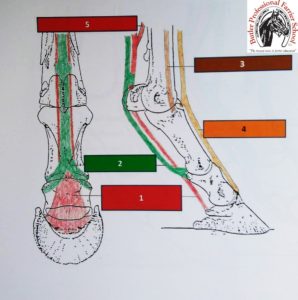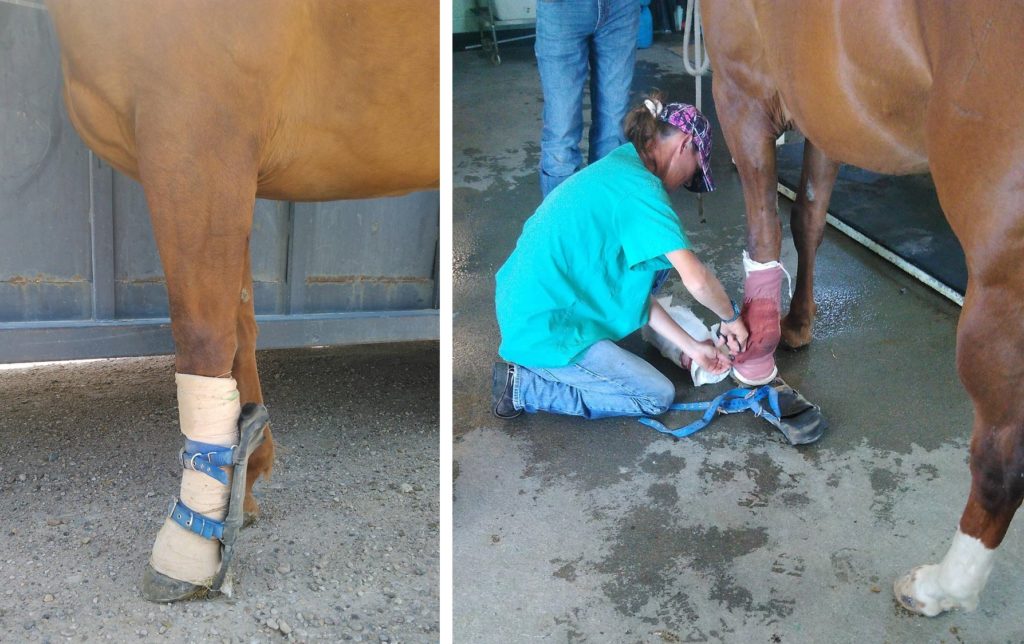Tendon Injuries

Tendons of the horse’s leg: 1) Deep Digital Flexor Tendon; 2) Superficial Digital Flexor Tendon; 3) Lateral Extensor Tendon; 4) Common or Long Extensor Tendon; 5) Sub-carpal Check Ligament of DDFT; Treatment of injuries is dependent upon location (From Essential Principles of Horseshoeing, Butler)
Tendon injuries can be devasting and career-ending for horses, depending on the severity of the damage and the availability of a knowledgeable veterinarian/farrier team. Horses have four major tendons in their lower legs. There are two extensor tendons in the front (common extensor and lateral extensor) and two flexor tendons in the back (superficial digital flexor (SDFT) and deep digital flexor (DDFT)). The flexor tendons (deep and superficial) are most commonly injured in horses that are underconditioned and overexerted.
Tendons do not have the elasticity of ligaments. Tendons are comparable to cables. This is necessary for the horse to move. Muscles contract and relax to make tendons move the lower limbs kind of like a puppet master manipulating a marionette through the use of strings. When one of these tendons is hyperextended—rather than stretching to accommodate the strain—the tendon simply ruptures or “bows.” Bowed tendons are painful to horses because the mechanism that allows them to move has been compromised. Horses have also been known to sever or cut their tendons on sharp objects like fences or farm equipment left in the pasture. The treatment to help these horses depends on the location of the injury.
Deep Flexor Tendon Injury/Treatment
The deep flexor tendon originates in the muscle of the upper leg in the forearm (front) or gaskin (hind). It runs into the foot and attaches to the bottom of the coffin bone. For this reason, an injured deep flexor tendon is relieved by elevating the heel. Of course, a skilled veterinarian will need to determine the extent of the injury and surgically repair the damage if necessary, but the farrier will need to apply a mechanical treatment that will allow the injured tendon to heal. Usually this is done by raising the heel of the horse’s foot.

Deep flexor tendon injuries should be treated by both the veterinarian and the farrier. This horse’s injuries were surgically treated by a vet and then mechanically treated by the farrier. A patten-bar shoe with a two inch lift was necessary to allow the horse to bear weigh on the afflicted leg. Note the horse resting the right hind leg once the shoe is applied.
For minor injuries, a wedge pad may be sufficient, but most deep flexor tendon injuries require a much higher lift. Patten bar shoes with heel lifts built into the shoe are useful in these cases. The veterinarian should work closely with the farrier. Some veterinarians will write a prescription for the type of shoe that is needed with a specification for the height of the lift. The principle is to put enough lift in the shoe until the horse can put weight on the injured leg; enough to relax the opposite leg. Injured horses tend to put all the weight on the opposite (uninjured) leg. Over time the uninjured leg can develop lameness issues due to excessive weight-bearing. It is wise to shoe the opposite uninjured leg with a frog support shoe to spread weight-bearing to the frog instead of the hoof wall. This often can’t be done until the injured leg is shod with a therapeutic shoe that allows them to finally rest the uninjured leg. The horse should be rested and encouraged to lie down by filling a stall with soft bedding.
Superficial Flexor Tendon Injury/Treatment
The superficial flexor tendon does not extend all the way into the foot. It originates in the muscles like the deep flexor tendon but it attaches to the bones (P1 and P2) on either side of the pastern joint. When there are injuries to the superficial flexor tendon, the fetlock is often pushed forward. Therefore, along with elevating the heel, supporting the fetlock is also key when treating these injuries. Again, the veterinarian should be involved with the medical and surgical treatment of the injury. The farrier can help a horse with this injury by applying a shoe with a brace to stabilize the fetlock joint. A pipe welded to the bottom of a shoe can offer some elevation and a bar that fits into either side of the pipe and then extends up the leg can then be wrapped with soft gauze and vet wrap to stabilize the fetlock and injured area. The opposite leg should be shod with a heart-bar as soon as possible. In severe injuries, it may not be possible to pick up the opposite leg because the horse will not want to put weight on the injured leg.

Superficial flexor tendon injuries are treated by elevating the foot as well as stabilizing the fetlock due to its position. This shoe has a pipe welded to the bottom of the shoe and the brace is hinged so that the veterinarian can fold back the brace in order to medically treat the wound.
For any injury, time is the great healer, but just the passage of the time will not do anything unless the horse has had the proper treatment to allow time to heal the injuries. Soft bedding is recommended to encourage the horse to lie down and take weight off the legs—but horses make poor patients. Very few horses want to lie down for extended periods of time. Therapeutic shoes should be applied to allow a horse to be the most comfortable it can be while recovering from its injuries.
Related Posts
-
By Doug Butler PhD, CJF, FWCF Recently, as I was searching t...May 02, 2019 / 0 comments
-
Often farriers are asked about the rings on the horse’s fo...Nov 30, 2016 / 0 comments
-
We all value our animals — both in terms of money and our ...Aug 23, 2018 / 0 comments
Blog Categories
- Anatomy
- Best Business Practices
- Conformation
- Current Events
- Customer Service
- Draft Horse Shoeing
- Equine Soundness
- Essential Anatomy Kit
- Farrier Careers
- Farrier training
- Foal soundness
- Horse Care
- Horse Foot Care
- Horse Owner Tips
- Horsemanship
- Horseshoeing
- Horseshoeing History
- Iron and Forge Work
- Student Spotlight
- Uncategorized
- Veterinary Care
Blog Archives
Contact Us
Butler Professional Horseshoeing School
495 Table Road
Crawford, NE 69339
(800) 728-3826
jacob@dougbutler.com
Subscribe to Our Blog
Get Our Free e-Book!
If you think you want to become a farrier (or know someone who does), this book can help you make that decision. Horse owners will learn the importance of choosing a qualified farrier and how to select the “right” one.
[ Get the e-Book Now! ]
- Follow:
